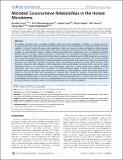Microbial Co-occurrence Relationships in the Human Microbiome
Author(s)
Faust, Karoline; Sathirapongsasuti, Jarupon; Izard, Jacques; Segata, Nicola; Gevers, Dirk; Raes, Jeroen; Huttenhower, Curtis; ... Show more Show less
DownloadFaust-2012-Microbial Co-occurre.pdf (1.348Mb)
PUBLISHER_CC
Publisher with Creative Commons License
Creative Commons Attribution
Terms of use
Metadata
Show full item recordAbstract
The healthy microbiota show remarkable variability within and among individuals. In addition to external exposures, ecological relationships (both oppositional and symbiotic) between microbial inhabitants are important contributors to this variation. It is thus of interest to assess what relationships might exist among microbes and determine their underlying reasons. The initial Human Microbiome Project (HMP) cohort, comprising 239 individuals and 18 different microbial habitats, provides an unprecedented resource to detect, catalog, and analyze such relationships. Here, we applied an ensemble method based on multiple similarity measures in combination with generalized boosted linear models (GBLMs) to taxonomic marker (16S rRNA gene) profiles of this cohort, resulting in a global network of 3,005 significant co-occurrence and co-exclusion relationships between 197 clades occurring throughout the human microbiome. This network revealed strong niche specialization, with most microbial associations occurring within body sites and a number of accompanying inter-body site relationships. Microbial communities within the oropharynx grouped into three distinct habitats, which themselves showed no direct influence on the composition of the gut microbiota. Conversely, niches such as the vagina demonstrated little to no decomposition into region-specific interactions. Diverse mechanisms underlay individual interactions, with some such as the co-exclusion of Porphyromonaceae family members and Streptococcus in the subgingival plaque supported by known biochemical dependencies. These differences varied among broad phylogenetic groups as well, with the Bacilli and Fusobacteria, for example, both enriched for exclusion of taxa from other clades. Comparing phylogenetic versus functional similarities among bacteria, we show that dominant commensal taxa (such as Prevotellaceae and Bacteroides in the gut) often compete, while potential pathogens (e.g. Treponema and Prevotella in the dental plaque) are more likely to co-occur in complementary niches. This approach thus serves to open new opportunities for future targeted mechanistic studies of the microbial ecology of the human microbiome.
Date issued
2012-01Department
Massachusetts Institute of Technology. Department of Civil and Environmental EngineeringJournal
PLOS Computational Biology
Publisher
Public Library of Science
Citation
Faust, Karoline et al. “Microbial Co-occurrence Relationships in the Human Microbiome.” Ed. Christos A. Ouzounis. PLoS Computational Biology 8.7 (2012): e1002606. CrossRef. Web.
Version: Final published version
ISSN
1553-734X
1553-7358